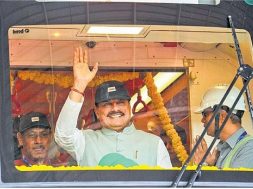Unscientific and indiscriminate uses of non environment friendly materials are threat to the global atmosphere. Indian concrete industry can play a proactive role in concern related to global sustainability. Raj Pillai, executive director of concrete products division at Sobha Developers recommends the road ahead
India has a civilization spanning over 5000 years and one of the reasons of such long spanning civilization could be usage of naturally available material in synchronization with nature for construction by then Indians. It is pertinent to mention that one of the theories revealing sudden disappearance of Egyptian civilization is natural calamity caused by excessive unsustainable construction activity.
Some of the very old buildings such as forts, palaces, temples etc. in India have withstood the test of time. And one of the main reasons for such long durability could also be attributed to usage of locally available building materials.
India, which is also a big country having diverse terrains and climatic conditions change almost every 300 kms and with it the natural resources for building material also change.
India produces approx 200 million tons of cement per annum. A lot of cement goes in to making plasters, blocks and allied products. Assuming 50 per cent of produced cement is used in making concrete, it can be safely assumed that around 300 million cubic meter of concrete is produced annually in our country. This also indicates that around 600 million tons of aggregate plus sand and 600 trillion litres of water are also used to produce such large volume of concrete. Also on a conservative estimate, the waste material generated from Indian construction industry alone stands at approximately twenty million tons.
The above figures are sizable not only in the Indian context but also in the global sustainability agenda with respect to embodied energy in buildings and energy required to produce and transport such large quantity of building materials.
As per a study conducted in 2005, the atmospheric level of carbon dioxide is highest in last 6,50,000 years. As a consequence, the year 2005 was recorded as one of the hottest year since mid 18th century. By 2010, emission of carbon dioxide globally was estimated at 75 billion tons and India’s contribution is around 8 billion tons which is next to China. The carbon dioxide generated into Indian atmosphere by virtue of cement industry alone stands at 200 million tons for every ton of cement produced, it is estimated that one ton of CO2 is generated!
One of the biggest damage being caused by current day construction is also usage of glass façade. In other words we build an air tight enclosure, cover it with glass, install heavy air-conditioning system and then emit huge amount of CO2 into atmosphere. The fact is in majority of places A/C could be avoided with little planning.
Ready mixed concrete industry started in India around 1995 only. Today almost 10 per cent of cement produced goes into RMC which is roughly around 50 million cubic meters of concrete in a year. One of the most sustainable method in concrete manufacturing in India could be by usage of cementitious material by way of RMC as India produces approximately 120 million tons of pulverized fly ash (PFA), almost 15 million ton ground granulated blast furnace slag (GGBS), around 5 million ton of silica fumes and more than hundred million tons of rise husk ash. In fact these materials and other locally available cementitious were extensively used by Indians in the past and some of the old buildings still bear testimony to it. The usage of such material would also create ‘Low cost housing’ in true sense.
Thomas Hommer Dixon in his book ‘Upside of down’ mentions about five tectonic stresses as:
1. Population stress
2. Energy stress
3. Environmental stress
4. Climate stress
5. Economic stress (gap between rich and poor).
In 1950 for every rich there were two poor, today it’s four and by 2025 it would be six across the world!
Global warming and increasing gap of rich and poor has a direct relationship as global warming is direct fall out of massive unsustainable construction being witnessed everywhere and if it goes unchecked, a repeat of collapse of civilization cannot be ruled out.
Conclusion:
Indian concrete industry can play a very proactive role in concern related to global sustainability. Some of the recommendations are as follows:
• Usage of quality cementitious material should be made mandatory for all concrete plants
• Usage of glass façade should be restricted
• Usage of Air conditioning should be discouraged by law as Indian climatic condition does not demand it
• Usage of crushed and recycled concrete aggregate [RCA] should be made mandatory
• Usage of agro waste and other biomass resources and natural fibers like rice husk, rise husk ash, biogases, sugar cane tops, coir fiber, straw, coconut and areca nut tree trunks and coconut leaf should be explored extensively
• Usage of mine waste from iron, copper and marble mines should be encouraged.
Building materials and their energy chart
Material
Energy per unit, MJ
Burnt Brick
3.75-4.5
Cement
5.85
Lime
5.63
Lime + Fly Ash
2.33
Steel
42
Aluminium
237
Glass
26
Sand
206
Marble
200
Polyester
220
GFRP
100
Clay Tiles
50
Raj Pillai is the executive director of concrete products division at Sobha Developers Ltd. A graduate in civil engineering from Bangalore University, Raj completed his two year managerial course in concrete and quarrying from Doncaster UK. He has been associated with commercial concrete business for the last 15 years and has pioneered the concept of ready-mix concrete in India. Raj has also worked at various construction sites in India and abroad having a total professional experience of 23 years.
Prior to joining Sobha, Raj was responsible for RMC business of a leading building products company looking after business in more than 30 cities and from 55 commercial concrete plants in India. He had also worked with Fletcher Challenge, ACC and Larsen and Toubro at various capacities in the past.
Raj has undergone various training sessions at Singapore, KL, UK and in India and has also presented various technical papers at national and international conferences and technical journals. Raj is the chairman of Indian Concrete Institute -Karnataka Bangalore Centre and also governing council member of Karnataka Employers Association. He is also member of Institute of Concrete Technology (UK) and Institute of Quarrying (UK). Raj was awarded ‘CHANGE MASTER ‘by Tasmac and Business Gyan in the year 2006 for pioneering RMC business in Bangalore.
Cookie Consent
We use cookies to personalize your experience. By continuing to visit this website you agree to our Terms & Conditions, Privacy Policy and Cookie Policy.









